With thanks to a travel grant from The Heritage Alliance in partnership with the British Council, I was recently able to travel to Nairobi to undertake field research on the heritage and history of the Mau Mau Uprising. With Antony Maina from National Museums of Kenya, as well as fellow Museum of British Colonialism team member Beth and research assistants Caroline and Henry, we travelled to Nyeri and explored a variety of sites, each sombre and surreal in their own way.
We revisited the sites of Mweru and Aguthi detention camps, now both used as high schools. Aguthi, now Kangubiri Girls High School, was founded as a school in 1965 – just five years after the conflict ended. We were taken around by Antony and one of the school’s caretakers, who informed us that there was a mass grave on site, where detainees held at Aguthi were buried during the Emergency. The area is down a path from the main school grounds, among a grove of trees with two benches. The area is eerily peaceful; it afforded us one of the few quiet moments in our long day of fieldwork, but it was hard to forget the site’s painful past.
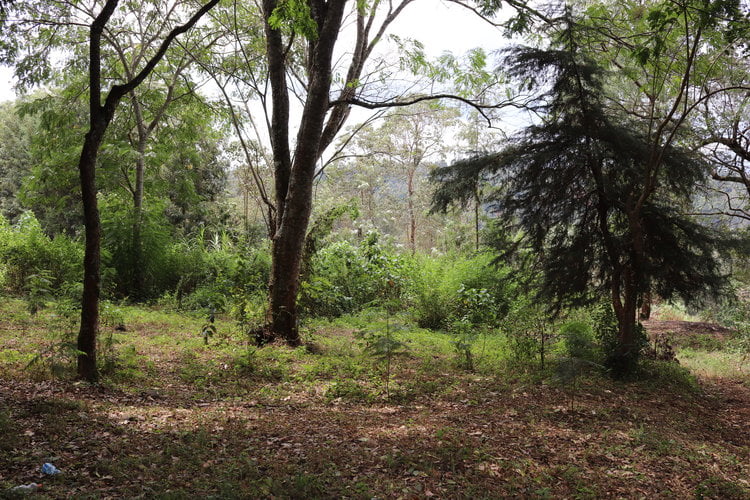
Mass grave at Aguthi Works Camp, now Kangubiri Girls High School
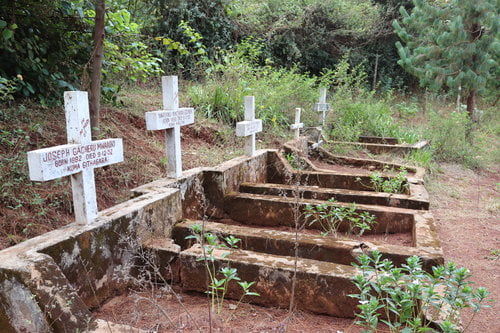
Graves at Gikondi Catholic Church
Antony then took us to Gikondi Catholic Church, where three Catholic Kenyans murdered by a group of Mau Mau fighters for their faith are buried. Antony tells us that their bodies were found after some weeks as they were dumped in a nearby river. With all the violence of the Mau Mau Uprising, the pain inflicted by both sides during the Emergency can sometimes be too easily forgotten, and unfortunately civilians were too often entangled in the conflict.
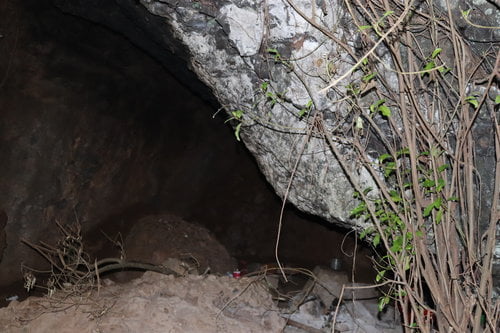
Kariba Caves, Nyeri
Later, we visited Kariba Caves, where Mau Mau commander General Kariba and his fighters hid after he was suspected of killing Louis and Mary Leakey, prominent British archaeologists living and working in Kenya at the time. A network of caves served as hideouts for Mau Mau fighters, who knew how to navigate the forests and local landscapes far better than the British forces. Our team member Maureen also recently visited Mau Mau caves in Meru, you can read and listen to her account here.
Kariba was eventually shot by British soldiers after they had captured his wife to lure him out of the cave. The site is down steep, winding paths, and the noise of the waterfall drowns out almost all sounds from the outside world. Today, the area is used by worshippers to pray, and their utensils and sleeping bags are scattered around the cave. It is, much like the grave at Kangubiri, a beautiful natural area that conceals its dark past.
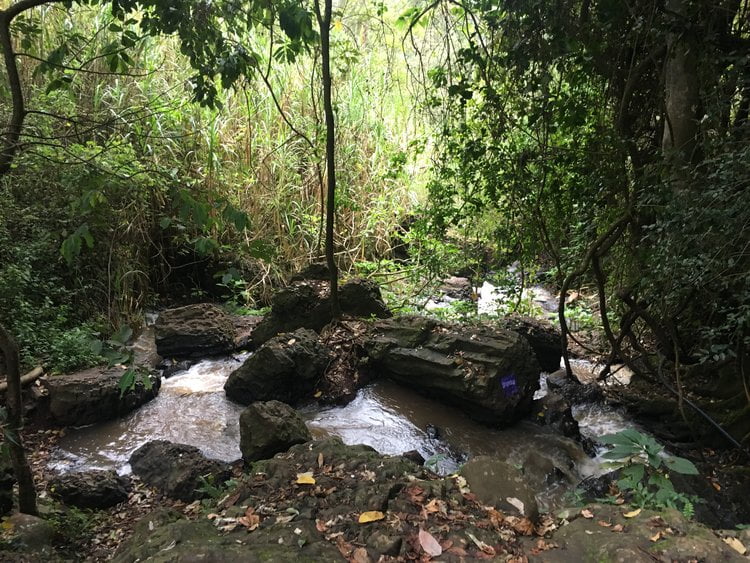
Outside Kariba Caves
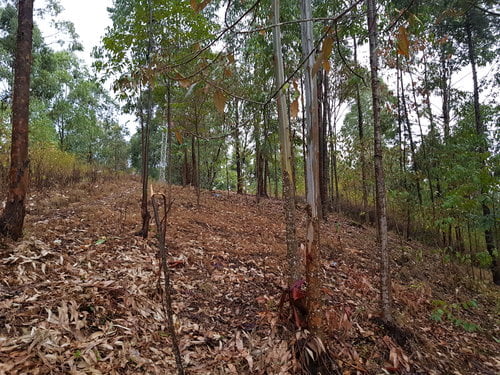
Sloping hill of the former emergency village
Finally we visited the site of a former emergency village, atop a steep hill and once surrounded by a trench. Emergency villages were adopted after their similar use by the British in Malaya. Communities of over a million Kikuyu were forcibly relocated into colonial-built villages in an attempt to cut off supply lines to Mau Mau fighters, the villages surrounded by deep, spiked trenches, barbed wire, and watchtowers. Today, nothing remains of the former site but its landscape; the remnants of a trench are visible before a steep hill. The village would have been at its foot, watched over by the homeguard post at the peak.
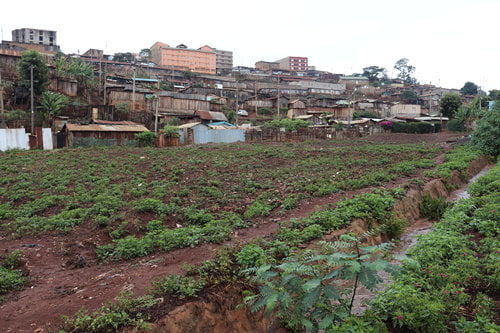
Mau Mau mass grave, with Kiawara in the background
On our second day in Nyeri, Antony took us around the town and guided us through Kiawara slum. In an unmarked lot of land lies a mass grave of Mau Mau fighters, the remains of whom are sometimes accidentally exhumed by farmers or workers. Antony tells me that though the site is gazetted by National Museums of Kenya, the local residents often attempt to farm or construct buildings on the area – and they may eventually have to be removed by force. This tension between archaeologists and the public crops up often, and as archaeologists we must constantly attempt to balance what we consider to be important to the public with the needs and wishes of local residents. This case is even more delicate not only with regards to the subject of the site, but also due to local community’s pressing need to create and secure sustainable livelihoods.

Recreated emergency village at Karatina University
Finally we visited Karatina University, where we were met by Professor John Mwaruvie. Professor Mwaruvie gave us a tour of the grounds, showing us their collection of Mau Mau artefacts and photographs at a small museum on the site, as well as their replica emergency village which is currently under construction. Just outside the campus is the trench of the former Karatina Works Camp, part of which has been excavated by the university in partnership with National Museums of Kenya and the British Institute in Eastern Africa. On the site is also an enormous fig tree (Mugumo), sacred in Kikuyu tradition. Mau Mau fighters would leave messages within the tree, often written on leaves in charcoal or blood. The work at Karatina is very promising, and will hopefully contribute towards further illumination and wider dissemination of knowledge of the Mau Mau Uprising.

Remains of trench at Karatina
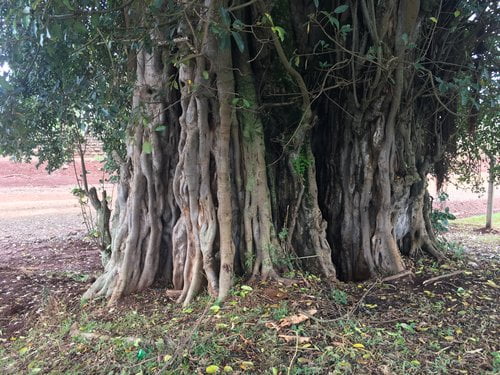
Mugumo tree at Karatina
While in Nairobi, I also got the chance to meet with our Museum co-founder Chao, and we worked on finding the best ways to develop an integrated digital map of the sites of the Mau Mau Emergency. You can find our initial work here. With time and further funding, we’ll be able to develop a map that integrates photographs, videos, and oral history interviews, and eventually go on to create 3D reconstructions of the camps and villages explored in our fieldwork and research.
My time spent in Nyeri and Nairobi was an incredible experience; though I spent a relatively short time in Kenya, I’ve certainly come away with a better understanding of the history, the landscape, and the present day context. My initial contact with the sites had only been through photographs of and editing videos from the previous fieldwork trip, and so to experience the sites first-hand was surreal and incredibly sobering. This trip, and seeing the extent of what has been wiped from historical records, has certainly emphasised the importance of listening to different voices and experiences to share these important stories across cultures and countries. I hope that by sharing these stories, we are able to inspire more people to question the commonly accepted narratives of empire, and listen to the people that were affected by – and continue to live with the legacy of – British colonialism.
By Hannah McLean